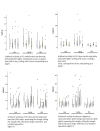Differences in muscle activity during hand-dexterity tasks between women with arthritis and a healthy reference group
- PMID: 24886491
- PMCID: PMC4060090
- DOI: 10.1186/1471-2474-15-154
Differences in muscle activity during hand-dexterity tasks between women with arthritis and a healthy reference group
Abstract
Background: Impaired hand function is common in patients with arthritis and it affects performance of daily activities; thus, hand exercises are recommended. There is little information on the extent to which the disease affects activation of the flexor and extensor muscles during these hand-dexterity tasks. The purpose of this study was to compare muscle activation during such tasks in subjects with arthritis and in a healthy reference group.
Methods: Muscle activation was measured in m. extensor digitorium communis (EDC) and in m. flexor carpi radialis (FCR) with surface electromyography (EMG) in women with rheumatoid arthritis (RA, n = 20), hand osteoarthritis (HOA, n = 16) and in a healthy reference group (n = 20) during the performance of four daily activity tasks and four hand exercises. Maximal voluntary isometric contraction (MVIC) was measured to enable intermuscular comparisons, and muscle activation is presented as %MVIC.
Results: The arthritis group used a higher %MVIC than the reference group in both FCR and EDC when cutting with a pair of scissors, pulling up a zipper and-for the EDC-also when writing with a pen and using a key (p < 0.02). The exercise "rolling dough with flat hands" required the lowest %MVIC and may be less effective in improving muscle strength.
Conclusions: Women with arthritis tend to use higher levels of muscle activation in daily tasks than healthy women, and wrist extensors and flexors appear to be equally affected. It is important that hand training programs reflect real-life situations and focus also on extensor strength.
Figures


Similar articles
-
Impairment of electrical activation of wrist flexor and extensor muscles during gripping and functional activities in the early stage of hand osteoarthritis: A cross-sectional study.J Hand Ther. 2021 Jan-Mar;34(1):109-115. doi: 10.1016/j.jht.2019.12.010. Epub 2020 Mar 7. J Hand Ther. 2021. PMID: 32156575
-
Wrist extensor muscle activity is less task-dependent than wrist flexor muscle activity while simultaneously performing moderate-to-high handgrip and wrist forces.Ergonomics. 2021 Dec;64(12):1595-1605. doi: 10.1080/00140139.2021.1934564. Epub 2021 Jun 11. Ergonomics. 2021. PMID: 34024262
-
Identifying tasks to elicit maximum voluntary contraction in the muscles of the forearm.J Electromyogr Kinesiol. 2020 Dec;55:102463. doi: 10.1016/j.jelekin.2020.102463. Epub 2020 Sep 8. J Electromyogr Kinesiol. 2020. PMID: 32950018
-
Contributions to the understanding of gait control.Dan Med J. 2014 Apr;61(4):B4823. Dan Med J. 2014. PMID: 24814597 Review.
-
Performance-based outcome measures of dexterity and hand function in person with hands and wrist injuries: A scoping review of measured constructs.J Hand Ther. 2022 Apr-Jun;35(2):200-214. doi: 10.1016/j.jht.2021.04.017. Epub 2021 Apr 18. J Hand Ther. 2022. PMID: 34253403
Cited by
-
Identification of forearm skin zones with similar muscle activation patterns during activities of daily living.J Neuroeng Rehabil. 2018 Oct 29;15(1):91. doi: 10.1186/s12984-018-0437-0. J Neuroeng Rehabil. 2018. PMID: 30373606 Free PMC article.
-
Acute Whole-Body Vibration Exercise Promotes Favorable Handgrip Neuromuscular Modifications in Rheumatoid Arthritis: A Cross-Over Randomized Clinical.Biomed Res Int. 2021 Dec 2;2021:9774980. doi: 10.1155/2021/9774980. eCollection 2021. Biomed Res Int. 2021. PMID: 34901282 Free PMC article. Clinical Trial.
-
Intramuscular fat and physical performance at the Framingham Heart Study.Age (Dordr). 2016 Apr;38(2):31. doi: 10.1007/s11357-016-9893-2. Epub 2016 Feb 22. Age (Dordr). 2016. PMID: 26899132 Free PMC article.
-
Toward Early and Objective Hand Osteoarthritis Detection by Using EMG during Grasps.Sensors (Basel). 2023 Feb 22;23(5):2413. doi: 10.3390/s23052413. Sensors (Basel). 2023. PMID: 36904616 Free PMC article.
-
Electromyography Parameters to Discriminate Hand Osteoarthritis and Infer Their Functional Impact.Sensors (Basel). 2024 Oct 18;24(20):6706. doi: 10.3390/s24206706. Sensors (Basel). 2024. PMID: 39460187 Free PMC article.
References
-
- Zhang W, Doherty M, Leeb BF, Alekseeva L, Arden NK, Bijlsma JW, Dinçer F, Dziedzic K, Häuselmann HJ, Herrero-Beaumont G, Kaklamanis P, Lohmander S, Maheu E, Martín-Mola E, Pavelka K, Punzi L, Reiter S, Sautner J, Smolen J, Verbruggen G, Zimmermann-Górska I. EULAR evidence based recommendations for the management of hand osteoarthritis. Report of a Task Force of the EULAR Standing Committee for International Clinical Studies Including Therapeutics (ESCISIT) Ann Rheum Dis. 2007;66:377–388. doi: 10.1136/ard.2006.062091. - DOI - PMC - PubMed
Publication types
MeSH terms
LinkOut - more resources
Full Text Sources
Other Literature Sources
Medical

